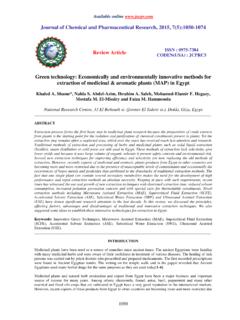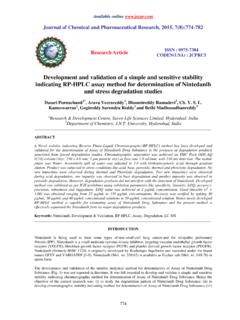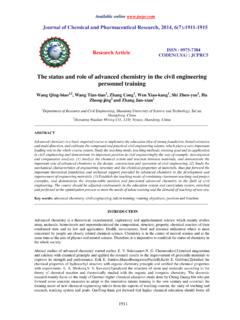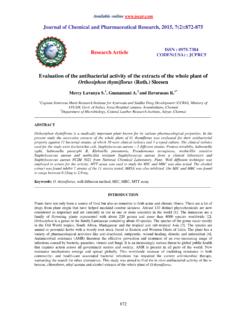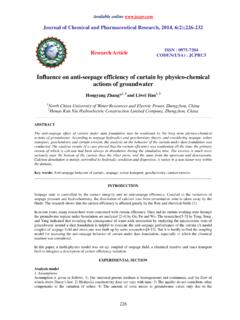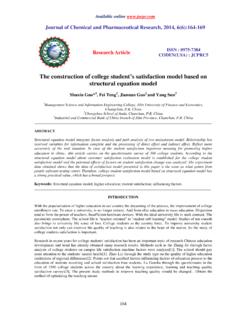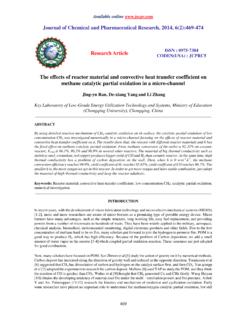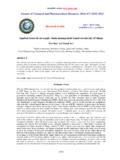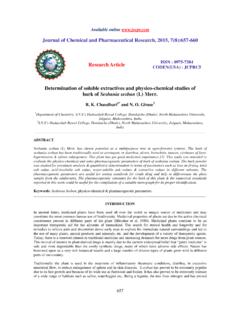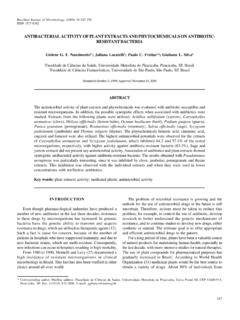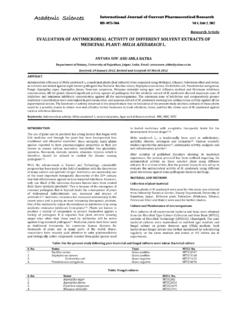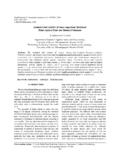Transcription of Journal of Chemical and Pharmaceutical Research
1 Available on line Journal of Chemical and Pharmaceutical Research _____ ISSN No: 0975-7384 CODEN(USA): JCPRC5 J. Chem. Pharm. Res., 2010, 2(4):7-15 7 Screening of Eight Plants Used In Folkloric Medicine for the Treatment of Typhoid Fever Musa *1, Yusuf , Ojogbane and Nwodo 1 Department of Biochemistry, University of Nigeria, Nsukka, Nigeria 2 Department of Biochemistry, Kogi State University, Anyigba, Nigeria _____ ABSTRACT Aqueous, ethanol and chloroform extracts of some plants used Igala folkloric medicine of North-Central Nigeria for the treatment of typhoid fever were investigated for their antibacterial properties against Salmonella typhi. Screening for the antibacterial activity was carried out by using a modification of the agar well diffusion technique.
2 The extracts that showed significant antibacterial activity were further investigated for their Minimum Inhibitory Concentrations [MIC]. The aqueous extract of D. oliveri and the ethanol extract of M. indica had MIC of which was comparable to that of gentamycin and better than those of amoxicillin and chloramphenicol, 25mg/ml and 100mg/ml respectively. However, the aqueous extract of N. latifolia which had an MIC of 25mg/ml had the widest zone of inhibition of all the extracts investigated from 25mg/ml to 100mg/ml concentration of the extracts. Thus weight for weight, the aqueous extract of N. latifolia was the most potent at higher concentrations.
3 The results obtained validate the use of A. occidentale, A. vogelii Planch, D. oliveri, M. indica and N. latifolia in Igala folkloric medicine for the treatment of typhoid fever. Keywords: Igala, Nigeria, S. typhi, typhoid fever, folkloric medicine _____ INTRODUCTION Typhoid fever is caused by Salmonella typhi [Gianella, 2006]. Typhoid fever remains an important public health problem particularly in developing countries with approximately 10 million cases and it results in about 700,000 deaths annually [Kariuki and Hart, 1997; Wasfy et al., 2000; Threlfall and ward, 2001]. In Nigeria, typhoid fever is among the major widespread diseases affecting both young children and adult in their productive years.
4 This is as a result of Musa et al J. Chem. Pharm. Res., 2010, 2(4):7-15 _____ 8many interrelated factors such as increased urbanization, inadequate supplies of potable water, overburdened healthcare delivery systems and indiscriminate use of antibiotics that contribute to the development of antibiotic resistant Salmonella typhi [Adeleye and adetosoye, 1993; Talabi, 1994]. The antibiotics that form the mainstay therapy for typhoid fever patients in developing countries are chloramphenicol, ampicillin, amoxicillin and cotrimoxazole. Resistant strains of S. typhi to these antibiotics have emerged and continues to be of clinical significance.
5 The frequent failure with empirical therapy observed in some hospitalized typhoid fever patients is as a result of widespread circulation antibiotic resistant strain of S. typhi [Saha et al., 1997]. Studies in Nigeria have shown that from 1997 to 2003, 80% of isolates of Salmonella typhi were multiple drug resistant [MDR], chloramphenicol being the most resisted antibiotic [83%] followed by ampicillin [ ]. Also the prevalence of chloramphenicol resistant isolates increased gradually from in 1997 to in 2003. Similar trends were also recorded for other antibiotics [Akinyemi et al., 2005]. Other studies confirm the increase in circulation of MDR- Salmonella typhi isolates over a relatively short period [Rowe et al.]
6 , 1991; Oboegbulam et al., 1995; Agbonlahan et al., 1997]. Even before the discovery of modern antibiotics and other chemotherapeutic agents, traditional medicine has served as man s resort when attacked by infective agents such as bacteria and fungi [Crafton, 1983]. Herbal medicine has still maintained its popularity in all regions of developing world and its use is rapidly spreading in industrialized countries [Patrick, 2002]. Furthermore, the active components of herbal remedies have the advantage of being combined with many other substances that appear to be inactive. However, these complementary components give the plant as a whole a safety and efficiency much superior to that of its isolated and pure active components [Shariff, 2001].
7 Recent work revealed the potential of several herbs as sources of drugs [Parekh and Chanda, 2007]. The first line of treatment for 60% of children with high fever in Ghana, Mali, Nigeria and Zambia resulting from typhoid fever and malaria is the use of herbal medicine [WHO, 2005]. The Igalas, in Kogi State, North-Central Nigeria use medicinal plants for the treatment of typhoid fever, but little work has been done to systematically identify and document these plants, study their pharmacological properties, domesticate and cultivate them, despite the fact that several of these plants face the danger of being lost due to the menace of deforestation and reluctance of people to venture into forest to harvest them.
8 Another real danger is losing this indigenous knowledge when the custodians die. Also there is still an urgent need to identify novel substances that are active towards pathogens with high resistance [Recio et al., 1989, Cragg et al., 1997, Barbour et al., 2004]. Some of the plants used in Igala folkloric medicine for the treatment of typhoid fever include Anacardium occidentale, Anthocleista vogelii Planch, Alchornea cordifolia, Cassia sieberiana, Daniela oliveri, Mamgifera indica, Nauclea latifolia and Triplochyton scleroxylon. Their mode of preparation and administration in Igala folkloric medicine are as presented in Table 1. Musa et al J.
9 Chem. Pharm. Res., 2010, 2(4):7-15 _____ 9 Table 1: Some Plants used in Igala Folkloric Medicine for the Treatment of Typhoid Fever Botanical name Local name Method of preparation and admistration Other uses Anarcadium occidentale Opigolo The leaves or bark boiled in water, the bark can also be soaked in alcohol, and is drunk over a period of time depending on the severity The bark is used for the treatment of ulcer and dysentery and the leaves as antifungal Anthocleista vogelii PlanchOdogwu The leaves boiled in water and is drunk over a period of time depending on the severity. Applied as poultice on swellings and to cleanse wound. Also used as an antifungal. Alchornea cordifolia Oyi The leaves boiled in water and is drunk over a period of time depending on the severity.
10 Treatment of stomach ache and other stomach disorders and sexually transmitted diseases. Used by women that have just given birth Cassia sieberiana Itolo The leaves or bark boiled in water, and is drunk over a period of time depending on the severity. The crushed leaves are soaked in alcohol and taking for a shorter period Used for the treatment of malaria. Roots used for the treatment of convulsion Daniela oliveri Oda The leaves boiled in water and is drunk over a period of time depending on the severity. Malaria and yellow fever treatment Mamgifera indica Umagolo The leaves or bark boiled in water, and is drunk over a period of time depending on the severity. The leaves or macerated bark can also be taken as tinctures in alcohol Treatment of malaria, diabetes and other diseases.
